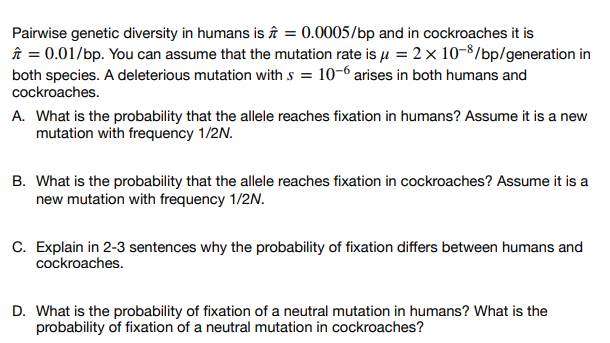Pairwise genetic diversity in humans is â = 0.0005/bp and in cockroaches it is ✩ = 0.01/bp. You can assume that the mutation rate is μ = 2 x 10-8/bp/generation in both species. A deleterious mutation with s = 10-6 arises in both humans and cockroaches. A. What is the probability that the allele reaches fixation in humans? Assume it is a new mutation with frequency 1/2N. B. What is the probability that the allele reaches fixation in cockroaches? Assume it is a new mutation with frequency 1/2N. C. Explain in 2-3 sentences why the probability of fixation differs between humans and cockroaches.
Pairwise genetic diversity in humans is â = 0.0005/bp and in cockroaches it is ✩ = 0.01/bp. You can assume that the mutation rate is μ = 2 x 10-8/bp/generation in both species. A deleterious mutation with s = 10-6 arises in both humans and cockroaches. A. What is the probability that the allele reaches fixation in humans? Assume it is a new mutation with frequency 1/2N. B. What is the probability that the allele reaches fixation in cockroaches? Assume it is a new mutation with frequency 1/2N. C. Explain in 2-3 sentences why the probability of fixation differs between humans and cockroaches.
Human Anatomy & Physiology (11th Edition)
11th Edition
ISBN:9780134580999
Author:Elaine N. Marieb, Katja N. Hoehn
Publisher:Elaine N. Marieb, Katja N. Hoehn
Chapter1: The Human Body: An Orientation
Section: Chapter Questions
Problem 1RQ: The correct sequence of levels forming the structural hierarchy is A. (a) organ, organ system,...
Related questions
Topic Video
Question
solve everything and give numerical answers with explanation.

Transcribed Image Text:Pairwise genetic diversity in humans is = 0.0005/bp and in cockroaches it is
✩ = 0.01/bp. You can assume that the mutation rate is μ = 2 x 10-8/bp/generation in
both species. A deleterious mutation with s = 10-6 arises in both humans and
cockroaches.
A. What is the probability that the allele reaches fixation in humans? Assume it is a new
mutation with frequency 1/2N.
B. What is the probability that the allele reaches fixation in cockroaches? Assume it is a
new mutation with frequency 1/2N.
C. Explain in 2-3 sentences why the probability of fixation differs between humans and
cockroaches.
D. What is the probability of fixation of a neutral mutation in humans? What is the
probability of fixation of a neutral mutation in cockroaches?
Expert Solution
This question has been solved!
Explore an expertly crafted, step-by-step solution for a thorough understanding of key concepts.
Step by step
Solved in 3 steps with 2 images

Knowledge Booster
Learn more about
Need a deep-dive on the concept behind this application? Look no further. Learn more about this topic, biology and related others by exploring similar questions and additional content below.Recommended textbooks for you

Human Anatomy & Physiology (11th Edition)
Biology
ISBN:
9780134580999
Author:
Elaine N. Marieb, Katja N. Hoehn
Publisher:
PEARSON

Biology 2e
Biology
ISBN:
9781947172517
Author:
Matthew Douglas, Jung Choi, Mary Ann Clark
Publisher:
OpenStax

Anatomy & Physiology
Biology
ISBN:
9781259398629
Author:
McKinley, Michael P., O'loughlin, Valerie Dean, Bidle, Theresa Stouter
Publisher:
Mcgraw Hill Education,

Human Anatomy & Physiology (11th Edition)
Biology
ISBN:
9780134580999
Author:
Elaine N. Marieb, Katja N. Hoehn
Publisher:
PEARSON

Biology 2e
Biology
ISBN:
9781947172517
Author:
Matthew Douglas, Jung Choi, Mary Ann Clark
Publisher:
OpenStax

Anatomy & Physiology
Biology
ISBN:
9781259398629
Author:
McKinley, Michael P., O'loughlin, Valerie Dean, Bidle, Theresa Stouter
Publisher:
Mcgraw Hill Education,

Molecular Biology of the Cell (Sixth Edition)
Biology
ISBN:
9780815344322
Author:
Bruce Alberts, Alexander D. Johnson, Julian Lewis, David Morgan, Martin Raff, Keith Roberts, Peter Walter
Publisher:
W. W. Norton & Company

Laboratory Manual For Human Anatomy & Physiology
Biology
ISBN:
9781260159363
Author:
Martin, Terry R., Prentice-craver, Cynthia
Publisher:
McGraw-Hill Publishing Co.

Inquiry Into Life (16th Edition)
Biology
ISBN:
9781260231700
Author:
Sylvia S. Mader, Michael Windelspecht
Publisher:
McGraw Hill Education